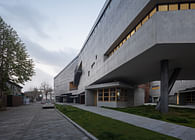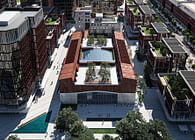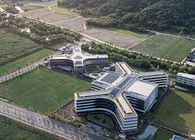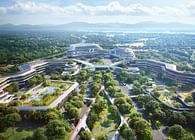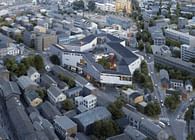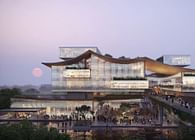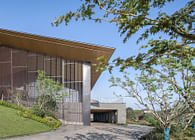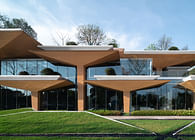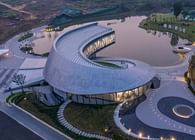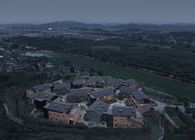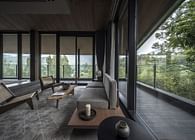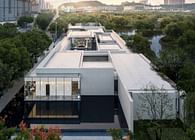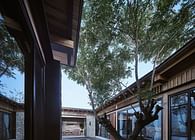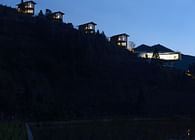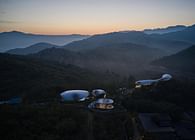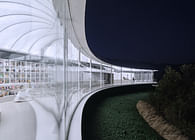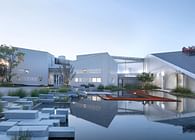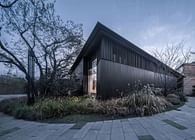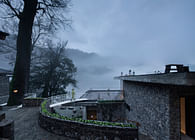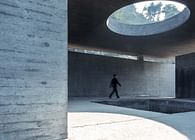
"Revitalizing and developing rural scenic areas requires a foundation in historical heritage and natural landscapes, while also embracing bold, future-oriented imagination and vitality."
— Zhu Peidong
Perched on the ridge of Xinchang in eastern Zhejiang, within the 19 Peaks Scenic Area, Xiayanbei Village is shrouded in mist and clouds year-round, creating a mystical atmosphere. This setting mirrors the imagery in Li Bai’s poem, 'The Song of Wandering the Sky at Mount Tianmu,' where clouds and mists obscure the peaks. The village, overlooking a sea of clouds and set against the Danxia landforms of 19 Peaks, has become a favored destination for outdoor enthusiasts. However, in recent years, the village's limited infrastructure and inadequate visitor capacity have increasingly hindered its sustainable development.
Invited to lead the enhancement of Xiayanbei's scenic area, Zhu Peidong, Co-Founder and Chief Architect of line+ studio, confronted two major challenges: addressing the typical obstacles of rural development, such as funding shortages, land scarcity, and business model homogeneity; and crafting a distinctive identity for Xiayanbei as a modern tourist destination.
In response, the design team employed a dual strategy: first, through careful pre-planning and site selection, leveraging existing infrastructure without requiring additional land quotas to create differentiated scenic experiences; second, by revitalizing existing land and spaces, integrating operational planning with composite design. This approach aimed to enhance infrastructure, benefiting both visitors and local residents by introducing new business models and increasing foot traffic.
The 'Woven Passage to Cloudy Peaks' and 'Sky Ring' are the initial projects in the enhancement of the Xiayanbei scenic area, introducing new infrastructure. These installations follow two distinct design strategies—'grounded' and 'elevated'—tailored to site conditions and landscape context, serving as the entrance and iconic landmarks of the area.
Rooted in Xiayanbei's cultural heritage and natural landscape, these strategies create unique sensory experiences through design and construction, establishing a cohesive narrative for visitors while enriching the daily life of local residents.
01. Memory and Craftsmanship: Woven Passage to Cloudy Peaks
The village entrance lacks a traditional boundary marker, gateway, or arch, leaving it without clear signage or transitional buffers. As a new destination, the client initially requested a standard gateway. However, after site evaluation, an alternative was proposed: transforming the gateway into a more memorable entry experience—a woven passage leading into the village and scenic area.
A passage was designed at the bend of the road between Houdaisan Village and Xiayanbei Village, turning the entrance signage into a distinctive experience. As one passes through, the sea of clouds and tea fields suddenly unfold before the eyes.
| Ecological Restoration and Sustainability
During the site survey, the design team observed that the village road construction years ago had split the natural hill between the two villages, leading to severe vegetation erosion and exposed soil, which frequently caused road blockages after rain. In 2018-2019, a simple concrete retaining wall was installed to mitigate soil erosion, but the persistent rainfall in Jiangnan continued to exacerbate soil loss.
The passage was designed not only to establish an entrance marker and create a memorable experience but also to contribute to ecological restoration. By replacing the original retaining wall and repairing the disruption to the natural hillside, the passage serves a dual purpose as a transportation landmark and as a critical component of the site's ecological restoration infrastructure.
The passage’s height is engineered to comply with transportation standards for buses and construction vehicles, while its external dimensions closely follow the original elevation of the hillside cut. This alignment ensures the structure naturally integrates with the terrain's contours. The design also incorporates tiered landscape retaining walls to seamlessly connect and stabilize the original slopes, employing natural forms and materials to achieve sustainable construction.
Xinchang is known for its rich tradition of bamboo weaving, a craft recognized as part of the region's intangible cultural heritage. Inspired by this, the architects chose natural wood as the primary structural material for the passage's interior. The integration of bamboo weaving techniques into the wooden framework allowed the load-bearing components to serve both structural and decorative purposes. This design approach not only creates visual tension within the woven passage but also revitalizes and preserves local craftsmanship in a contemporary form.
The exterior is clad in locally sourced black slate, enabling the structure to blend seamlessly into the surrounding tea fields and forest, becoming a natural extension of the landscape.
The form, softened by curves, closely adheres to the mountainside. The fluid double-curved structure guides the eye through a controlled interplay of light and shadow, creating a tension that evokes the sensation of 'passing through.' This mirrors the spatial narrative in Tao Yuanming's 'Peach Blossom Spring,' where a narrow path opens into a broad, illuminated space. This experience is recreated within the woven passage’s twenty meters, offering a moment of revelation and transformation.
| Complex Curved Surface Design
The challenge in designing the double-curved wooden structure lies in aligning geometric shape with material stress. Collaborating with Luanlu Structural Design Firm, calculations were made for shear strength, torsional resistance, and critical bending points of the laminated timber to reinforce all weak areas. This rigorous process ensured the structural viability of the complex load-bearing passage.
| Precision Prefabrication System
Transitioning from design to construction required meticulous planning and precise coordination. During design development, parametric software like Rhino-Revit was employed to model the double-curved beams and nodes, ensuring accurate curvature and positioning. The optimal 13mm Douglas fir was selected based on the required bending radius and thickness. Components were then CNC-machined, pre-assembled, and transported to the site for final assembly.
After the wooden framework was completed, it was clad with stainless steel mesh, secured by galvanized steel ribs, and natural fracture stone slabs were fastened with metal wires. The irregular texture of the slabs, handcrafted by local artisans, added a raw, natural quality to the prefabricated structure.
02. Distinctive Landmark: Sky Ring
Xiayanbei Village’s main activities—mountain viewing, cloud watching, camping, hiking, and farming—are all heavily weather-dependent. The 'Sky Ring,' an IP installation themed around meteorology, not only serves as a visual landmark but also functions as a meteorological balloon, providing multi-layered weather forecasts for villagers and tourists through its visible ascent and data collection.
The goal was to go beyond the conventional meteorological balloon, making the Sky Ring a new public symbol for Xiayanbei. When inflated, it becomes a landmark visible from miles away and creates a shared space for tourists and villagers beneath its shadow.
The site for the Sky Ring was carefully selected for its accessibility, ease of gathering, and suitability for balloon operations. Positioned on a hillside near the parking lot, it is centrally located within the tea fields, with the 19 Peaks as a backdrop, enhancing the camping and outdoor experience for visitors.
| Aerostatic Installation
The aerostatic installation was designed to balance aerodynamics, distinguish it from traditional spherical balloons, and meet safety standards. After exploring various forms, the architects chose a ring-shaped helium balloon as the optimal solution.
The Sky Ring measures 30 meters in outer diameter and 5.5 meters in inner diameter, comprising subsystems for the balloon, avionics, lighting, inflation and retrieval, support, and foundational infrastructure. In winds below 8 m/s, it ascends to 25 meters, tethered by 16 evenly distributed cables. When winds exceed 8 m/s or during adverse weather, four outer cables signal the management system to activate the winch, retrieving the ring. Six inner and eight outer cables then anchor it securely, enhancing wind resistance.
The ring features 33 LEDs that light up at night, infusing the quiet rural landscape with dynamic energy and modern flair. Using RGBW technology, the LEDs deliver high brightness with low energy consumption, offering a broader color spectrum and more vibrant hues.
The ring is constructed from a multilayer fabric laminate composite, chosen for its air-tightness, light weight, environmental resistance, durability, and ease of assembly. It consists of 66 thermally welded pieces, filled with helium to provide buoyancy. Internal airbags balance pressure, ensuring safety.
03. Anchoring Memory, Shaping the Future
The natural environment and development needs of Xiayanbei Village prompted reflection on the balance between local memory and future growth. 'Anchoring local memory' shows respect for the built environment, while 'shaping a distinctive future' boldly addresses new demands, creating future memories in harmony with tradition. The 'Ascending the Heavens and Descending the Earth' project merges traditional memories with modern technology, offering visitors a unique experience and providing the village with new opportunities and aesthetics. The structures, blending seamlessly with the landscape, position Xiayanbei as a distinctive landmark amid increasingly standardized rural scenic areas.
The soaring Sky Ring has become a must-see attraction, drawing visitors to capture photos from any spot in the village, even visible from neighboring villages and highways. Its widespread sharing has enhanced Xiayanbei's unique atmosphere, creating lasting memories for tourists and revitalizing daily life for villagers.
Status: Built
Location: Shaoxing, CN
Firm Role: Architecture
Additional Credits: Project Name: Woven Passage to Cloudy Peaks & Sky Ring
Design Firm: line+ studio
Chief Architect/Project Principal: Zhu Peidong
Design Team: Wu Haiwen, Shi Yixiong (Architecture); Li Shangyang, Rao Feier, Jin Jianbo, Zhang Wenjie (Landscape)
Client: Shijiufeng Scenic Area Development Co., Ltd.
Project Location: Xiayanbei Village, Xinchang, Zhejiang
Design Period: 2022.02-2022.11
Construction Period: 2022.12-2023.05
/ Woven Passage to Cloudy Peaks
Structure: Luan Qi Construction Architectural Design Firm
Construction: Hangzhou Zhongpu Architectural Technology Co., Ltd.
Wood Structure Fabrication: Liaoning Jinbaisheng Wood Structure Technology Co., Ltd.
Floor Area: 210m²
Structure: Timber Structure
Material: North American Douglas Fir and Slate
/Sky Ring
Design Development, Production, and Installation: China Special Aircraft Research Institute
Construction Drawing Partner: Zhejiang University of Technology Engineering Design Group Co., Ltd.
Material: Multilayer Fabric Laminate Composite






